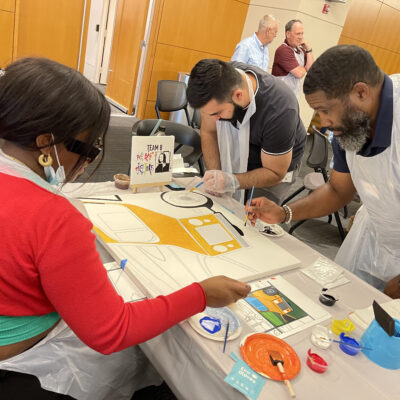The general definition of “mindfulness” is “a mental state achieved by focusing one’s awareness on the present moment, while calmly acknowledging and accepting one’s feelings, thoughts, and bodily sensations, used as a therapeutic technique.” When it comes to the workplace — the place most of us spend the majority of our waking hours — mindfulness can bring a host of benefits. Scientific studies have proven that employees that practice mindfulness in the workplace experience everything from reduced stress to improved concentration.
Here is a closer look at 10 of those benefits of mindfulness, and how teaching employees to prioritize their own mental health can result in happier, more productive teams.
1. Improved adaptability.
Everything does not, unfortunately, always go to plan. Employees who practice mindfulness at work have proven to be far better at facing those unexpected challenges head-on, making them far more resourceful and better leaders for their teams. They are the employees who can pivot seamlessly when the situation calls for something new and can lead their teams to success.
2. Stress reduction.
Stress is a major factor in modern life and something everyone, to some degree, is dealing with. By practicing mindfulness, employees will experience everything from better sleep to fewer illnesses and sharper minds. Less stressed employees are also happier in their workplaces, and the joy they bring to their performance shines through.
3. Better cognition.
Brain fog — it is something we all experience. Stress and anxiety are significant contributors to this state, so learning to practice mindfulness can help clear away the proverbial cobwebs, improving memory and retention.
4. Improved problem-solving.
Along with overall better memory comes the ability to make connections — this, in turn, leads to the ability to find solutions to problems that either might have been overlooked or will have taken far longer to realize.
5. Better relationships.
Teams are made up of individuals, and the best teams are all moving in the same direction, working toward the same goals. A team that practices mindfulness at work will see improved empathy with one another, better understanding, and in general, foster better communication.
6. Improved creativity.
Being mindful means having an open mind and seeing the bigger picture, providing the perfect breeding ground for creativity and innovation. Flexible thinking is far easier when starting from a place of mindfulness.
7. Improved memory.
It is worth mentioning again — mindfulness leads to better memory. The ability to focus on the present moment allows employees to pay more attention to the details and have the mental bandwidth to commit those details to memory.
8. Better health.
Practicing mindfulness in the workplace can help regulate negative emotions, which means having more regulated emotional responses. Being aware of emotions and reactions means being able to deal with them in the moment, rather than getting overwhelmed, reducing stress, anxiety, and depression. These all contribute to everything from quality of sleep, heart health, and chronic pain — being mindful means taking control.
9. Gaining perspective.
It can be easy to get bogged down in the “daily grind” and day-to-day tasks that must be done. But practicing mindfulness can help put those tasks into context, making them part of the larger whole, the cogs that help the machine function, so to speak, rather than just random parts.
10. Improved concentration.
Modern society is a study on distractions — emails, phone calls, texts, video chats, meetings… there is always something trying to claim attention. Mindfulness, however, is the practice of being in the “now” — by intentionally choosing to only focus on what needs to be done at the moment, rather than everything else can help employees stay more productive and feel less burned out at the end of the day.
To learn more about mindfulness in the workplace and how to cultivate the practice with your team, listen to the latest episode of the TeamBuilding Saves the World podcast, where Fiona Jensen and Paula Reardon Webster of Calmer Choice — a non-profit organization that provides mindfulness-based prevention programs to students and community members throughout Barnstable and Plymouth County, Mass. — join Rich Rininsland for an in-depth discussion about the importance and benefits of mindfulness.












